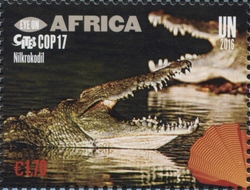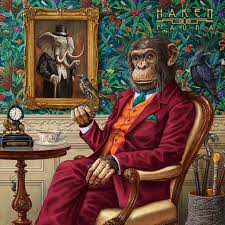Stamp: Eye on Africa - CITES COP17 - Nile crocodile (United Nations, Offices in Vienna Austria 2016)
Eye on Africa - CITES COP17 - Nile crocodile (United Nations, Offices in Vienna Austria 2016)
24 September (United Nations, Offices in Vienna Austria ) within release Eye on Africa goes into circulation Stamp Eye on Africa - CITES COP17 - Nile crocodile face value 1.70 Euro
| Stamp Eye on Africa - CITES COP17 - Nile crocodile in catalogues | |
|---|---|
| WADP Numbering System - WNS: | WAD:UN325.16 |
Stamp is horizontal format.
Number in set - 4||(show set). Layout - miniature sheet of 4 of 4 designs. Issuing - United Nations Postal Administration. Printer - Cartor Security PrintingAlso in the issue Eye on Africa :
- Stamp - Eye on Africa - CITES COP17 - Nile crocodile face value 1.70;
- Stamp - Eye on Africa - CITES COP17 - Cape vulture face value 1.70;
- Stamp - Eye on Africa - CITES COP17 - Ground pangolin face value 1.70;
- Stamp - Eye on Africa - CITES COP17 - Mystacidium capense face value 1.70;
- Mini Sheet - Eye on Africa face value ;
Stamp Eye on Africa - CITES COP17 - Nile crocodile it reflects the thematic directions:
Reptiles are tetrapod (four-limbed vertebrate) animals in the class Reptilia, comprising today's turtles, crocodilians, snakes, amphisbaenians, lizards, tuatara, and their extinct relatives. The study of these traditional reptile orders, historically combined with that of modern amphibians, is called herpetology. Because some reptiles are more closely related to birds than they are to other reptiles (e.g., crocodiles are more closely related to birds than they are to lizards), the traditional groups of "reptiles" listed above do not together constitute a monophyletic grouping (or clade). For this reason, many modern scientists prefer to consider the birds part of Reptilia as well, thereby making Reptilia a monophyletic class.
Fauna (pl.: faunae or faunas) is all of the animal life present in a particular region or time. The corresponding terms for plants and fungi are flora and funga, respectively. Flora, fauna, funga and other forms of life are collectively referred to as biota. Zoologists and paleontologists use fauna to refer to a typical collection of animals found in a specific time or place, e.g. the "Sonoran Desert fauna" or the "Burgess Shale fauna". Paleontologists sometimes refer to a sequence of faunal stages, which is a series of rocks all containing similar fossils. The study of animals of a particular region is called faunistics.


